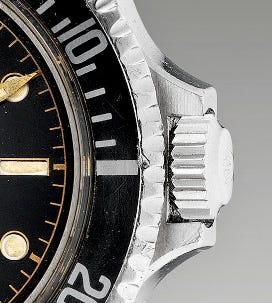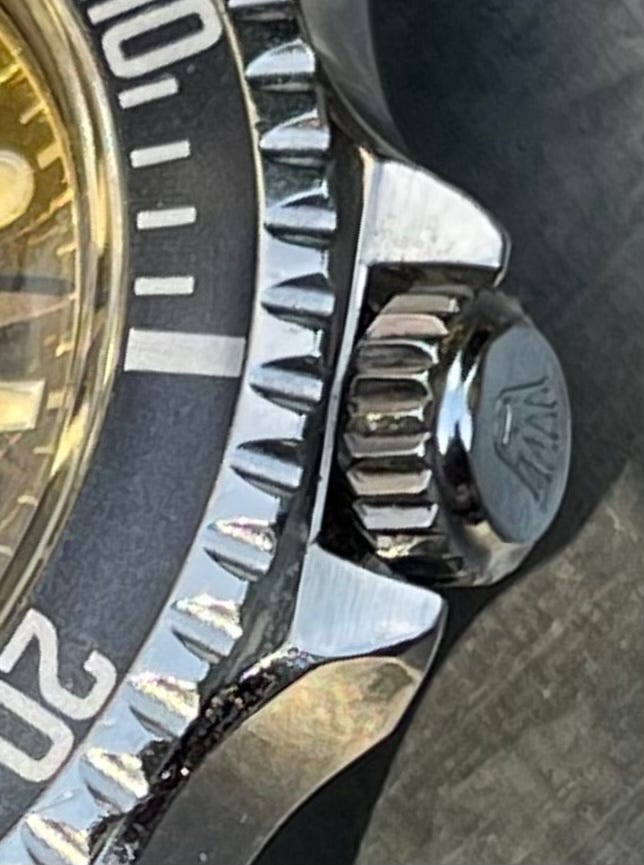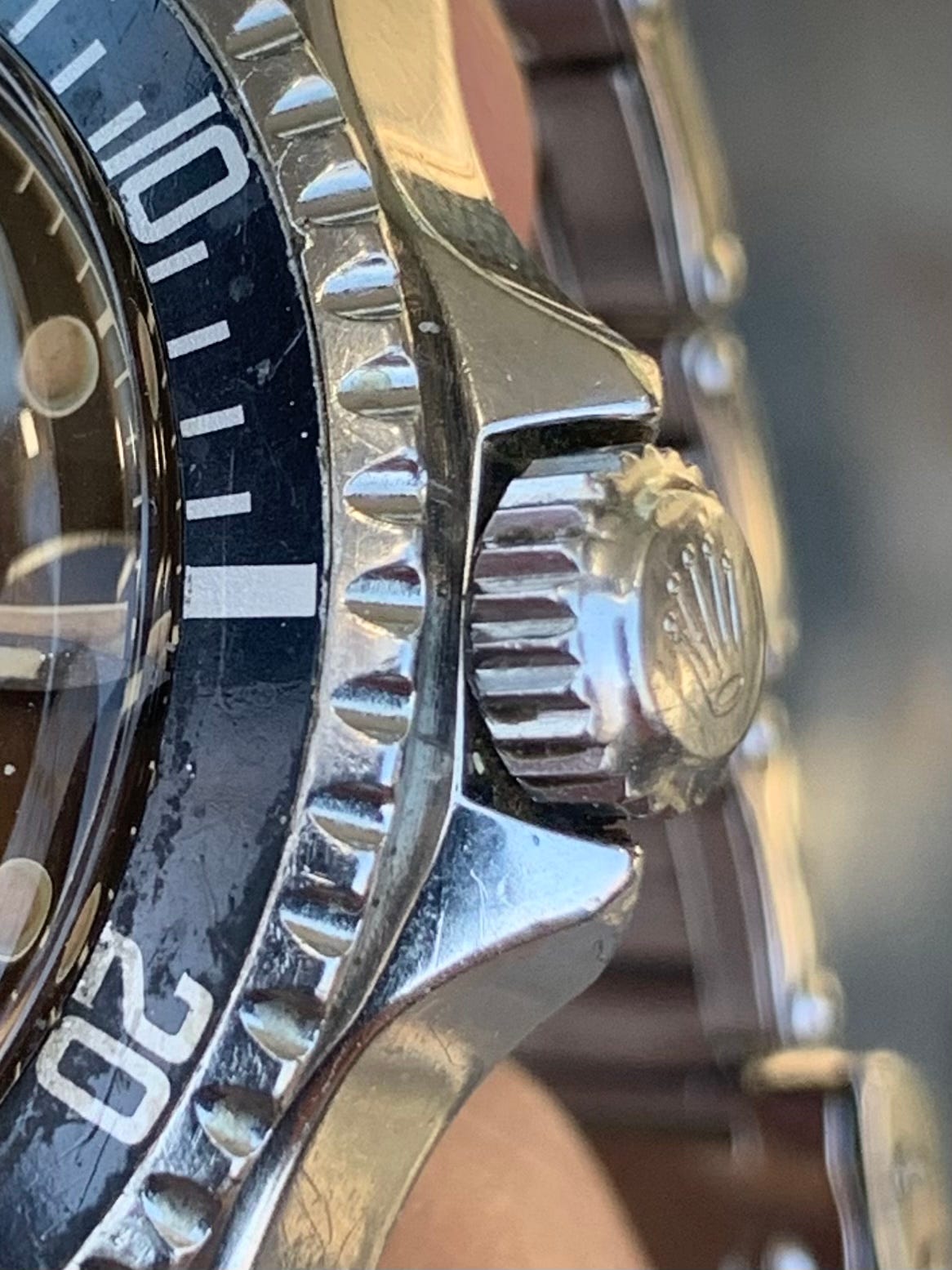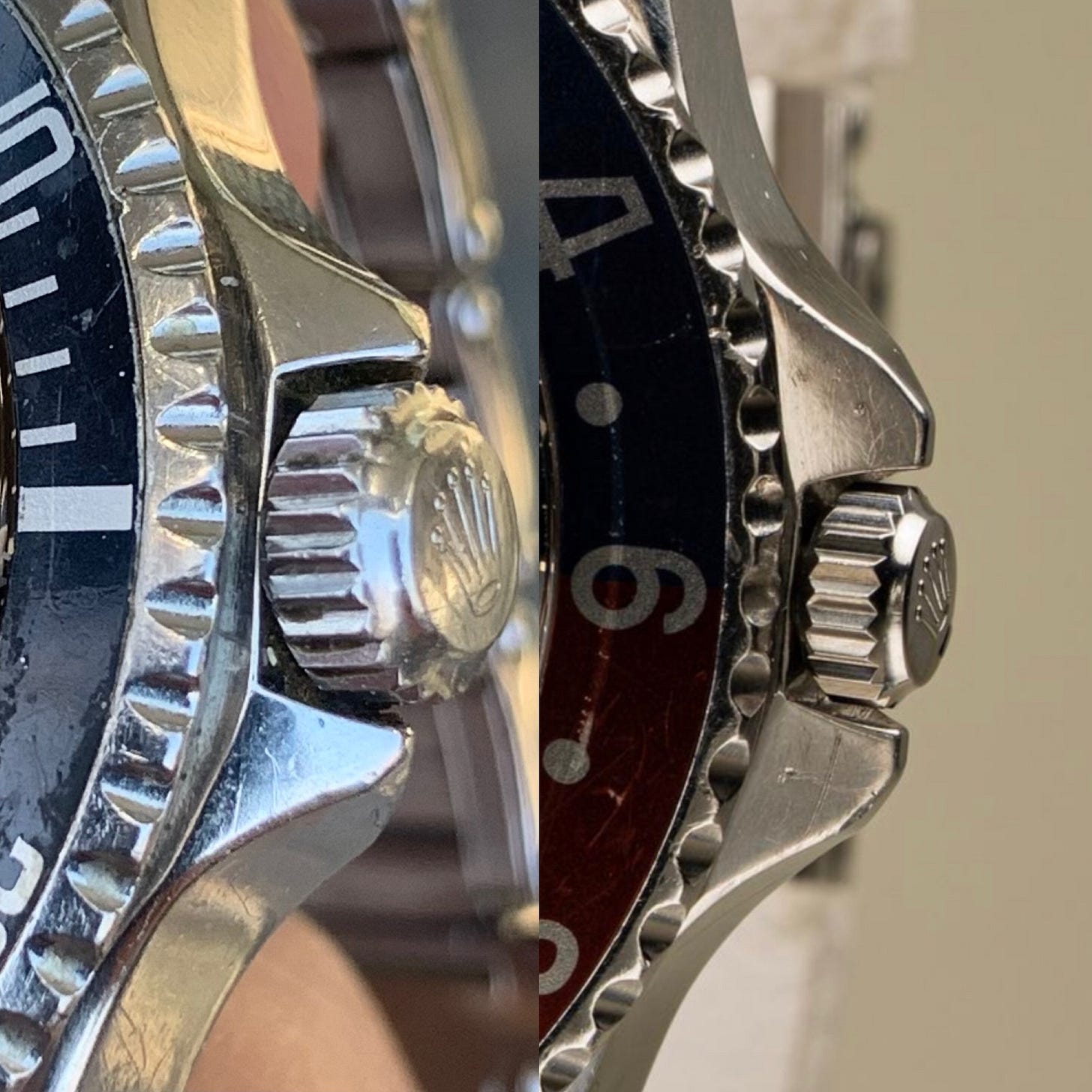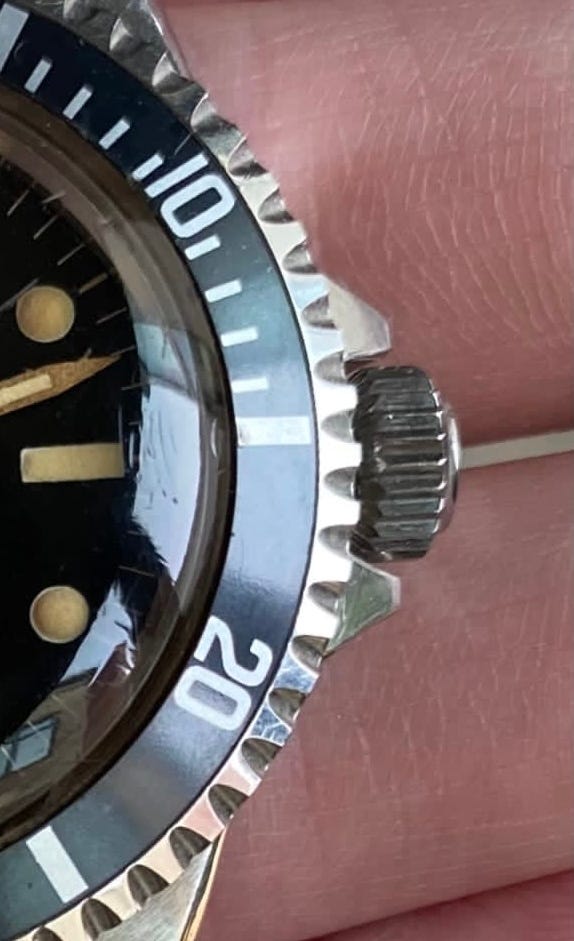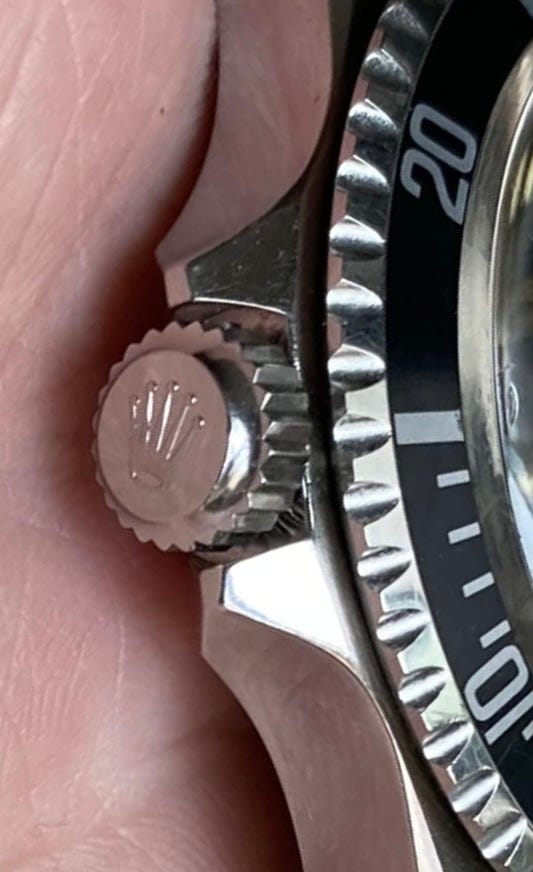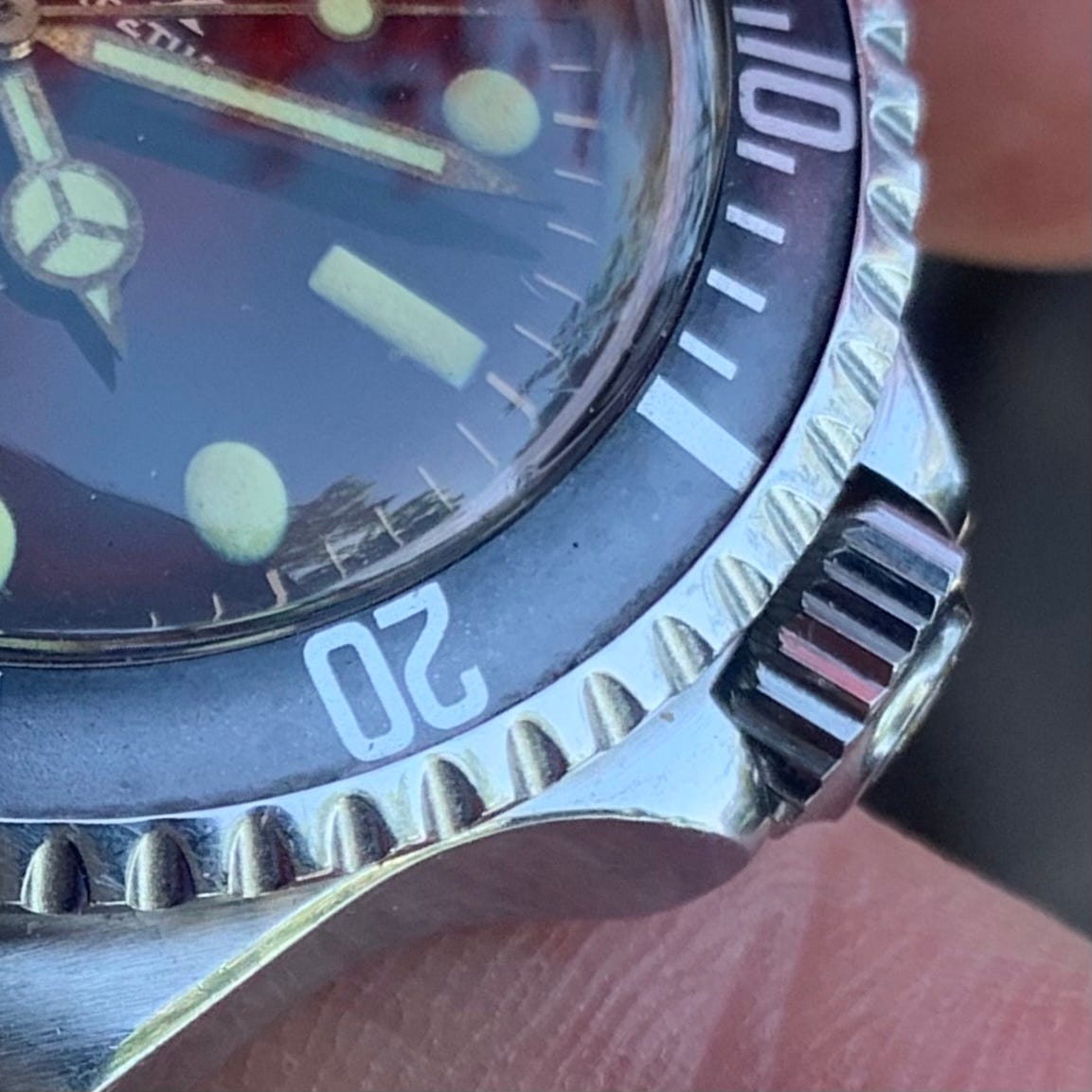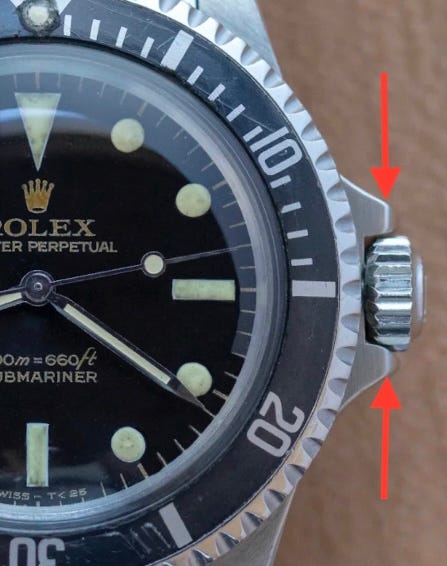The Submariner model was introduced by Rolex in the early ‘50’s. It was a purpose built watch for divers. Crown guards began appearing on Submariner models beginning with the 5512 reference, introduced in 1959. These guards were added to provide protection to the winding crown that could be knocked and damaged during diving or use in water-based activities
The first Mark 1 guards featured very pronounced chamfers running to the tip and were a robust square in shape. The Mk1 are very rare and it’s reported that only approx. 100 examples are known. These examples are seen around the later 477xxx serial number range. An example (courtesy of Phillips) is shown in Fig. 1.
Fig. 1
The guards evolved to a Mark 2 iteration known as “eagle beak” by collectors shown in Fig. 2 (courtesy @beaumont_miller_ii). These are extremely rare and currently there are less than 30 known. There are differing views about their original development. It’s been conjectured and published that they were likely shaved down from the original square shape. Another view is that they were developed from scratch as their own unique shape, as is believed by some experts. Given the bowed out shape, the latter view makes sense to me. The reasoning behind the change from a square shape is believed to allow the user more dexterous access to the crown while diving. These concave top, Mark 2 guards are seen starting from serial 478,xxx. There is a very interesting article by @le_monde_edmond comparing the 5512 eagle beak to the 1675 “cornino. It served as an inspiration for my original post about this Submariner crown guard topic on my instagram account in the past. You can read the article by Edmond Here.
Fig. 2
The Mark 3 crown guard type is noted next, briefly and up to very early ‘60 serial numbers. I believe this type to be transitional, have a quite limited production and overlooked by most reports recognizing the Mk1 square, Mk2 eagle beak and then on to the Mk4 pointed guard evolution. The Mk3 has an appearance somewhat similar to the eagle beak with 3 facets, but has a slimmer, flat, downward angled rather than a concave top side. It’s appearance is also similar to the so-called “cornino” style previously mentioned and seen on early 1675 gilt examples, but is more slender and shaped like a beak than a horn to my eyes. The differences are subtle, but observable. I state that point via comparison between two examples that appear unpolished (see Fig. 4 side by side with 1675 courtesy of @watchand). A Mk3 example with serial 544xxx is shown in Fig. 3.
Fig. 3
Fig. 4
The Mark 4 is what most collectors typically typically refer to as a “pointed” guard. This style was seen on reference 5512 and eventually 5513 from ‘60-‘63/‘64. It differs from the Mk3 by sporting two vs. three facets, straighter lines with a larger blunt tip and slightly less of a downward slope. Technically speaking, Mk2 - Mk4 are all “pointed” guards by design and could be called as such in a macro sense, because they are in the same family. That said, each has a distinctly different shape. The Mk4 shape is shown in Figs. 5 and 6 below (courtesy @sensui).
Fig. 5
Fig. 6
Later in ‘64, the pointed Mk4 guard transitioned to the rounded Mark 5 guard on open chapter 5513 and 5512 gilt examples. The tips of these rounded guards are thicker and broader near the crown. Perhaps that was one of the reasons for change from a pointed design, to provide additional metal protection around the crown. An example from ‘66 is shown in Fig. 7.
Fig. 7
Finally, this rounded guard developed a flatter and slight facet on top to complete the gilt era crown guard evolution with this Mark 6 type during the late ’66 run, most commonly seen on “Bart” dial examples shown in Fig. 8 (courtesy Hodinkee Submariner Reference Points). This Mk6 type would carry over to the early matte era references.
Fig. 8
In summary, I present my view of how the gilt Submariner crown guard development evolved over time, comprising six distinct Marks fitting into three groups during the gilt era as noted:
Original
Mk1- Square
Pointed
Mk2- Eagle Beak
Mk3 – Beak transition
Mk4- Pointed
Round
Mk5- Rounded
Mk6- Rounded, flat top
Closing Remarks
This work is based on my own research, personal experience, observations from ownership and mutual sharing of knowledge within the collector community. I do find it interesting that six different types of crown guards are noted over a seven year span of production. This tells a story of product design development and I hypothesize that Rolex was iterating multiple aspects of the model based on functionality and likely to also achieve production efficiencies.
It’s important to remember that during this time, there were considerable hand finishing steps required compared to present times, even considering the fact that Rolex is and was a mass produced product, albeit with much lower production volumes at that time. I believe this combination of factors is why we now recognize so many different designs over such a short span of time. Observations such as this are one of the reasons I personally find a draw to the ‘50’s - ‘60’s, even ‘70’s in particular, given the charm of bygone times and the relative difficulty of finding and observing examples that have survived to this day in top condition with minimal intervention to their original state.
🙏🏻 for reading.
* Special thanks to @beaumont_miller_ii and @manhattanrollie for editorial review




